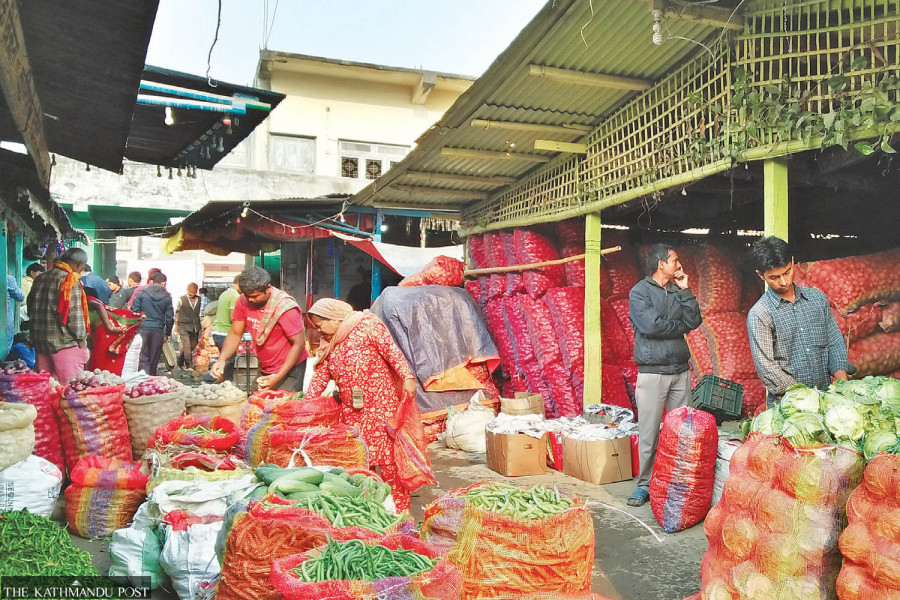Money
Unexpected dip puts official inflation figures in doubt
Central bank says mid-October to mid-November inflation rate dropped sharply to 5.38 percent, a 22-month low.
Krishana Prasain
Nepal’s monthly consumer inflation, which hovered over 7 percent over several months, came as a surprise for many when the central bank issued a new report on Thursday.
The mid-October to mid-November inflation rate dropped sharply to 5.38 percent, a 22-month low.
Interestingly, inflation dropped during Nepal’s key festival season when prices traditionally increase, not only due to demand, but also increased hoardings and black marketing due to lax monitoring.
“Earlier, I had said that the calculation of CPI inflation of the Nepal Rastra Bank is not right. How does inflation, which was 7.5 percent in the month of Asoj, come down to 5.38 percent this month [Kartik or mid Oct-mid Nov]?” Mukti Aryal wrote on X on Thursday.
“Inflation declined by 2.12 percent in a month when the price of goods has not decreased except some vegetables,” said Aryal, who has a decade-long experience in Nepal’s capital market.
Business journalist Gajendra Budhathoki, too, wrote on X, “In the month of mid-November, the price increases due to the festivals. Has the inflation declined by 2.12 percent by magic?” he questioned.
Many have questioned the central bank’s data as “cherry-picking”.
Urmila Adhikari, a retired school teacher in Kausaltar, too, is surprised.
“The Dashain and Tihar were expensive. From rice to sugar, transport fare to clothes, every single good in the market was expensive,” said Adhikari. “Since the Covid pandemic, inflation has made life difficult for many.”
“The cost of living in Kathmandu is high,” Adhikari said.
Let’s talk about commodity prices.
During Dashain and Tihar, the sugar price rose to Rs160 a kg. After India slapped the minimum export price, the wholesale price of onion jumped to Rs125 per kg. Every vegetable item was above Rs100 a kg.
The price of cumin seed (jeera), an indispensable spice, reached Rs1,400 to Rs1,500 per kg during the Dashain festival. A 25 kg bag of rice that used to cost Rs1,800 jumped to Rs2,400.
In Tihar, a kg of pistachio that cost Rs1,700 during last year’s Tihar was priced at Rs2,200.
Likewise, dried dates that used to cost Rs200 per a last year were priced at Rs400 a kg.
Krishna Bahadur Wagle, proprietor of Krishna Fancy Store at Sankata Bazaar in Kathmandu, told the Post in September-end that customer footfall during the festive season was disappointing compared to past years.
“It was due to high inflation. The per piece price of newly ordered readymade clothing increased by Rs300-400,” he said.
“Compared to last year’s Dashain festival, the prices of all clothing items have increased by more than 20 percent.”
The appreciation of the United States dollar against the Nepali rupee has made all imported items very expensive.
The Nepali rupee has plunged to 133 against the dollar compared to 127.91 a year ago during mid-October.
There were no significant changes in the price of petroleum products during the festive time.
Defying market prices, the central bank said that food and beverage category inflation stood at 6.01 percent, whereas non-food and service category inflation came to 4.89 percent in the mid-October to mid-November period.
In the review period, under the food and beverage category, the consumer price index of the spices sub-category increased 36.46 percent, sugar and sugar products 14.59 percent, fruits 14.01 percent, cereal grains and their products 12.02 percent, and milk products and eggs 11.00 percent.
The price index of the ghee and oil and vegetable sub-category decreased by 14.23 percent and 5.35 percent respectively in the review month.
Economist Keshav Acharya said that inflation has not declined.
“It’s demand compression.”
Consumers are spending less as slow economic growth led to many job losses, and companies laid off employees.
He said that due to the high interest in deposits, people stacked their cash in banks. Investors too did not invest in new ventures because of the high interest on credit.
“There was a sudden decline in demand even though there was no disruption in supply,” said Acharya.
Economists say the central bank still calculates inflation using a traditional method and, as a result, the data are not scientific.
There are around 1,200 commodities in the consumption basket and the central bank has not changed the base of consumer price in the past 10 years, said Acharya.
“Many goods in the CPI basket that are computed to ascertain inflation need to be updated. There are many new goods and commodities in the market now.”
“The data presented by the central bank, however, is not wrong,” he said.
With India imposing export restrictions on rice, wheat, sugar and onion and Nepal imposing VAT on imported potatoes, onions and other vegetables, prices were up, he said.
Currently, the price of bricks, stones, iron and steel has declined, said Acharya. The market is depressed, shutters are down, and people’s movement in department stores has nosedived, he added.
Economist Pushkar Bajracharya said subdued demand impacted the prices resulting in the drop in inflation.
“The goods in the central bank’s CPI basket do not cover 100 percent prices,” said Bajracharya.
“The goods in the basket are not reviewed frequently. As a result, the central bank’s inflation data does not match market rates,” he said.
He, however, said that the drop in inflation by 2.12 percent in a month, was unexpected.
“The government programmes are not focused on taming inflation. So, there is no way inflation will come down in the coming months as well.”




 11.12°C Kathmandu
11.12°C Kathmandu















